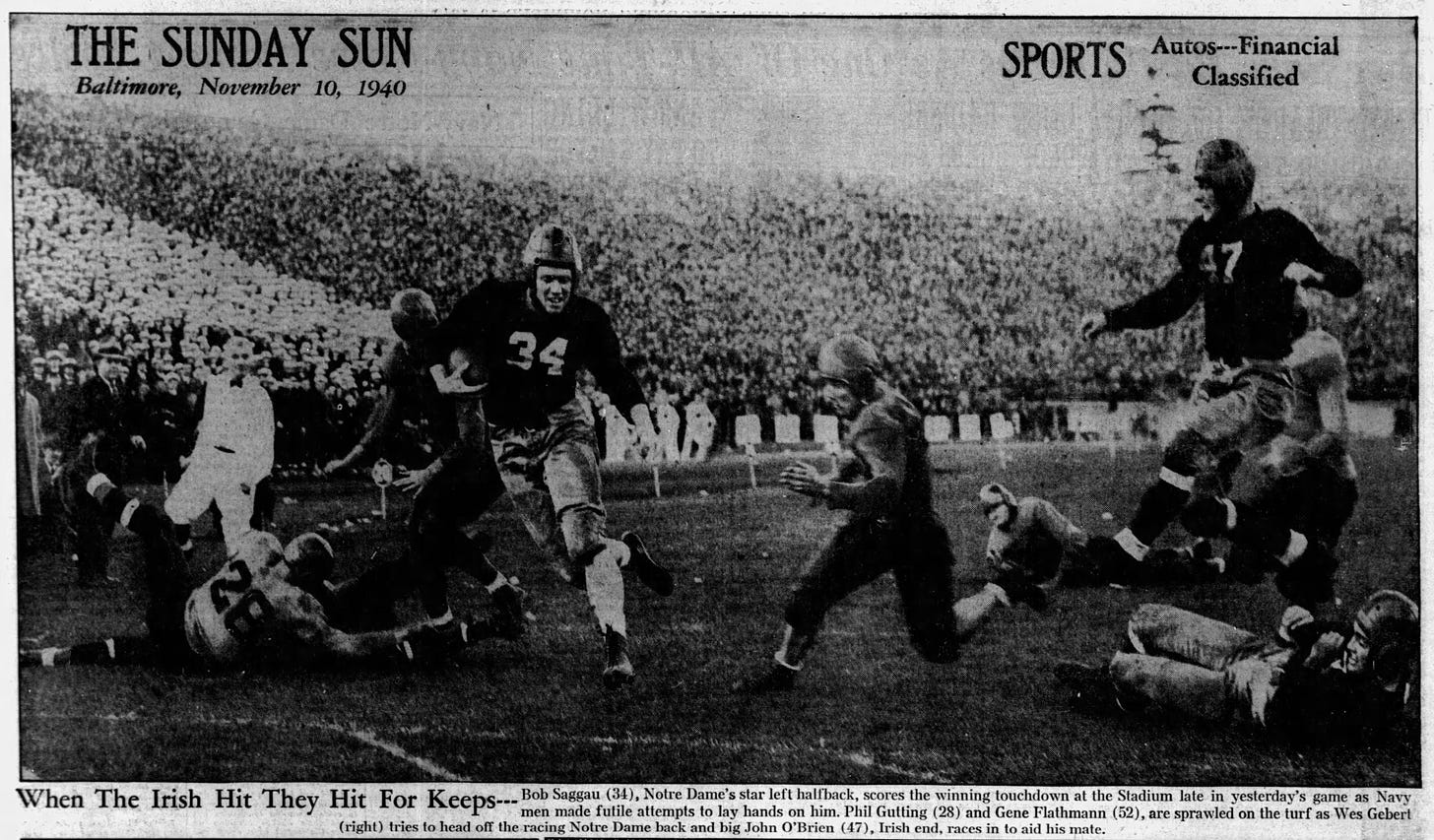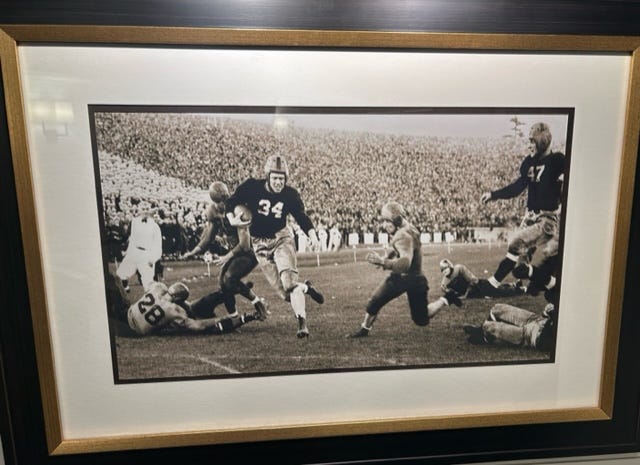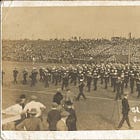Today's Tidbit... Digging Into A Mystery Image
I did not have a Today's Tidbit written while browsing Twitter and saw that Paul Lukas at Uni Watch had asked whether anyone could identify the teams playing in the picture below. Since I solved the mystery earlier today, I thought it would be fun to document the path I took to get there. The story shows that first impressions count -for good and bad- and that the truth is often revealed only by looking at the complete picture and not getting caught up in specific details.

By the time I saw Paul's tweet, others had already made guesses about the image, including several pointing to Notre Dame as one of the teams, which made sense to me. Like another commenter, I thought the uniforms were from the mid-to-late 1930s, which led me to get caught up in what appeared to be the obvious answer.
Thinking Notre Dame was one of the teams, I looked at the 1935 and 1936 Notre Dame yearbooks. Notre Dame's uniforms largely matched those in the Uni Watch image, but Notre Dame did not wear numbers on their chests until 1937, so that pointed me toward the Fighting Irish in the late 1930s. One of Notre Dame's opponents during the period was Carnegie Tech. A yearbook image showed Carnegie wearing helmets similar to those in the Uni Watch picture, so I checked Carnegie Tech's yearbooks for the period. That approach did not lead anywhere since Carnegie Tech switched helmet models and striping in 1937. At that point, I still thought Notre Dame was the team scoring the touchdown, but I was not making progress in determining their opponent.
Having quickly focused on Notre Dame, I decided to step back and literally look at the big picture. Scanning the Uni Watch image again, I saw that the left side of the image showed a portion of the crowd that I initially viewed as a "card section" or a student group whose members flipped cards of different colors to display designs. After a second look, the white section looked like Navy Midshipmen wearing white hats, not a card section. I also noted the male cheerleaders in white uniforms and the white banners or signs along the bottom of the stands.
Figuring the opponent was Navy, I looked at their 1937 and 1938 yearbooks, but they wore dark helmets that did not match the opponent's helmets in the image. However, the 1937 Navy yearbook included a picture of the Middies marching on a field surrounded by stands with box seats at the bottom. The box seats were faced with white cloth or wood resembling those seen in the Uni Watch image, helping make the case that Navy was the opponent, but which stadium included those box seats?
Continuing with Navy yearbooks, the 1939 version included an image of Navy cheerleaders in front of the Middie cheering section. That image also resembled the Uni Watch picture, so Navy still seemed like the right target, but Navy's 1939 uniforms still did not match those in the Uni Watch picture.
At that point, I checked jhowell.net, a site providing historical scores and locations, to see where they played the Notre Dame-Navy game during the era and found they played at Baltimore's Municipal Stadium in the years Navy hosted.
Turning to the 1941 Navy yearbook, the uniforms and helmets in Navy's team picture matched those from the Uni Watch image, but the yearbook did not include an image identified as being from the Notre Dame game, so I returned to Notre Dame's yearbooks. Leafing through the 1941 volume, I found a game-action image from the 1940 Navy game, showing teams whose uniforms matched the Uni Watch image.

Things were looking good, so I turned to newspapers.com to find newspaper reports from November 9, 1940, and learned they played an exciting game. Even Grantland Rice called it a Notre Dame-Navy classic.
Before 63,000, the largest crowd in Baltimore since the 1924 Army-Navy game, the Fighting Irish took the lead in the first quarter on a long touchdown pass from halfback Bob Saggau to Bob Dove, but they missed the extra point.
Navy threatened to score three times but could not cross the goal line until the fourth quarter when they ran it over and converted to take a 7-6 lead with five minutes left. Notre Dame then returned to the air, using their passing game to move the ball downfield until they had it on Navy's 4-yard line. After several plays that ended in Notre Dame losing two yards, halfback Bob Saggau took the ball on a sweep to the right, cut inside a kickout block and ran untouched for the winning score.
Of course, the Baltimore Sun’s pictorial page included several images of the game and crowd, including a picture of the game-winning touchdown that matched the Uni Watch image I was searching for.
Of course, not every attempt to solve an image mystery ends up with everything tied up with a neat bow, but it is fun when it happens, even when you realize you wasted time by thinking about and viewing the big picture from the beginning.
FWIW, my first post on my old site, Fields of Friendly Strife, concerned solving the mystery behind a series of postcards. The story now appears as the first story on Football Archaeology, so click below if interested.
Football Archaeology is reader-supported. Click here to buy one of my books or otherwise support the site.







Tim, I’m the one who reached out to Paul to help identify the photo. I’m so grateful for your help and research. After I learned the history of the image I also found a great photo of it from the Chicago Tribune that also identifies the players. I couldn’t seem to attach it here, but it’s out there if you have the newspapers.com access. Very cool and I told Paul too how satisfying it was to figure this out. Thanks again. - Jon B.